View in other NatureServe Network Field Guides
NatureServe
Montana
Utah
Wyoming
Idaho
Wisconsin
British Columbia
South Carolina
Yukon
California
New York
Straightbeak Buttercup - Ranunculus orthorhynchus
State Rank Reason (see State Rank above)
Rare in Montana, where is is known from the western portion of the state based upon several specimen collections. However, only one collection has been made in the past two decades. Additional data are need to determine this species' status.
- Details on Status Ranking and Review
Population Size
Score2-3 - Very Small to Small: Population size is imprecisely known but is believed to be <10,000 individuals.
Commentpopulation estimates from known locations are unavailable.
Range Extent
Score2 - Regional or State Endemic or Small Montana Range: Generally restricted to an area <100,000 sq. miles (equivalent to 2/3 the size of Montana or less) or Montana contributes 50% or more of the species’ range or populations OR limited to 2-3 Sub-basins in Montana.
CommentMost observations/collections are at least several decades old, thus the species' current distribution is uncertain.
Area of Occupancy
Score2-3 - Very Low to Low. Occurs in 10 or fewer Subwatersheds (6th Code HUC’s), though the species' distribution is not sufficiently documented to place it within one class.
CommentMost observations/collections are at least several decades old, thus the species' current distribution is uncertain.
Environmental Specificity
Score1 - Moderate: Species is restricted to a specific habitat that is more widely distributed or to several restricted habitats and is typically dependent upon relatively unaltered, good-quality habitat (C Values of 5-7).
Trends
ScoreNA - Rank factor not assessed.
Threats
Score2-3 - High to Very High.
CommentInvasive species and trampling have been identified as real or potential threats.
Intrinsic Vulnerability
Score1 - Moderate Vulnerability: Specific biological attributes, unusual life history characteristics or limited reproductive potential makes the species susceptible to extirpation from stochastic events or other adverse impacts to its habitat and slow to recover.
Raw Conservation Status Score
Score
10 to 13 total points scored out of a possible 16 (Rarity factors and threats only).
General Description
Stems 20–75 cm, somewhat hollow, erect or decumbent with hirsute to nearly glabrous foliage. Basal leaf blades narrowly ovate, 3–15 cm long, pinnate, the 3 to 5 leaflets deeply 1 to 2 times lobed. Flowers with petals 9–14 mm long, almost twice as long as the pilose sepals. Achenes flattened, 2–4 mm long, glabrous with straight beak ca. 3 mm long; head ovoid, 8–12 mm high (
Lesica et al. 2012. Manual of Montana Vascular Plants. BRIT Press. Fort Worth, TX).
Phenology
Flowering from June-early August.
Species Range
Montana Range
Range Descriptions
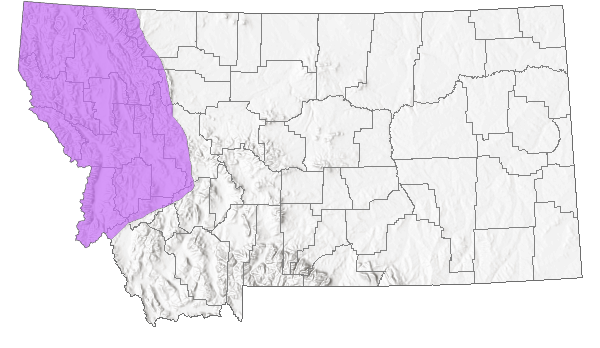
 Native
Native
Range Comments
AK south to CA, UT and WY (Lesica et al. 2012. Manual of Montana Vascular Plants. BRIT Press. Fort Worth, TX).
Observations in Montana Natural Heritage Program Database
Number of Observations: 18
(Click on the following maps and charts to see full sized version)
Map Help and Descriptions
Relative Density
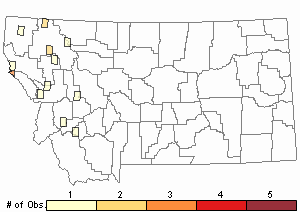
Recency
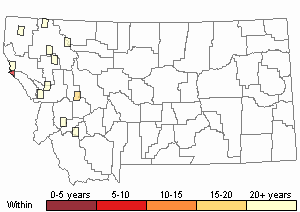
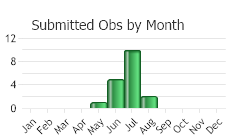
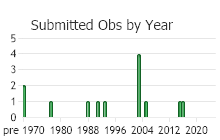
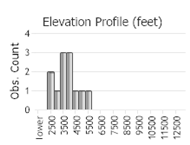 (Observations spanning multiple months or years are excluded from time charts)
(Observations spanning multiple months or years are excluded from time charts)
Habitat
Streambanks and moist meadows in the montane zone.
National Vegetation Classification System Groups Associated with this Species
Grassland
Montane - Subalpine Grassland
Wetland and Riparian
Alpine Riparian and Wetland
Riparian Shrubland
Wet Meadow and Marsh
Ecology
POLLINATORS The following animal species have been reported as pollinators of this plant species or its genus where their geographic ranges overlap:
Bombus auricomus,
Bombus bifarius,
Bombus nevadensis, and
Bombus bimaculatus (Macior 1968, Thorp et al. 1983).
Stewardship Responsibility
Threats or Limiting Factors
STATE THREAT SCORE REASON
Reported threats to Montana's populations of Straightbeak Buttercup are impacts from non-native species, and potential impacts due to trampling by hikers (MTNHP Threat Assessment 2021). One population occurs where non-native plants and a hiking trail are found. Competition with non-native plants has ongoing negative impacts, and these may be exacerbated by recreational use. Information on population impacts due to recreation that occur within a 10-year time frame are needed to evaluate the relative contribution from this threat.
References
- Literature Cited AboveLegend:
 View Online Publication
View Online Publication Lesica, P., M.T. Lavin, and P.F. Stickney. 2012. Manual of Montana Vascular Plants. Fort Worth, TX: BRIT Press. viii + 771 p.
Lesica, P., M.T. Lavin, and P.F. Stickney. 2012. Manual of Montana Vascular Plants. Fort Worth, TX: BRIT Press. viii + 771 p. Macior, L.M. 1968. Bombus (Hymenoptera, Apidae) queen foraging in relation to vernal pollination in Wisconsin. Ecology 49:20-25.
Macior, L.M. 1968. Bombus (Hymenoptera, Apidae) queen foraging in relation to vernal pollination in Wisconsin. Ecology 49:20-25. MTNHP Threat Assessment. 2021. State Threat Score Assignment and Assessment of Reported Threats from 2006 to 2021 for State-listed Vascular Plants. Botany Program, Montana Natural Heritage Program, Helena, Montana.
MTNHP Threat Assessment. 2021. State Threat Score Assignment and Assessment of Reported Threats from 2006 to 2021 for State-listed Vascular Plants. Botany Program, Montana Natural Heritage Program, Helena, Montana. Thorp, R.W., D.S. Horning, and L.L. Dunning. 1983. Bumble bees and cuckoo bumble bees of California (Hymenoptera: Apidae). Bulletin of the California Insect Survey 23:1-79.
Thorp, R.W., D.S. Horning, and L.L. Dunning. 1983. Bumble bees and cuckoo bumble bees of California (Hymenoptera: Apidae). Bulletin of the California Insect Survey 23:1-79.
- Additional ReferencesLegend:
 View Online Publication
View Online Publication
Do you know of a citation we're missing? King, C. R. 1953. The Ranunculaceae of Montana. M.S. Thesis, Bozeman, MT: Montana State College. 82 p.
King, C. R. 1953. The Ranunculaceae of Montana. M.S. Thesis, Bozeman, MT: Montana State College. 82 p. Lesica, P., M.T. Lavin, and P.F. Stickney. 2022. Manual of Montana Vascular Plants, Second Edition. Fort Worth, TX: BRIT Press. viii + 779 p.
Lesica, P., M.T. Lavin, and P.F. Stickney. 2022. Manual of Montana Vascular Plants, Second Edition. Fort Worth, TX: BRIT Press. viii + 779 p.
- Web Search Engines for Articles on "Straightbeak Buttercup"





